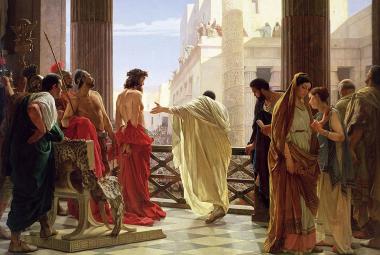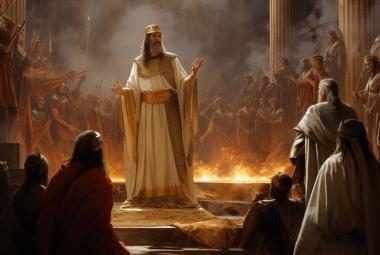For I have not shunned to declare unto you all the counsel of God.
Acts 20:27
Our Lord repeatedly instructed us: “Be not deceived.” That is an imperative: a command, not simply a suggestion. But how? What are the tools to prevent our being deceived or misled?
In this opening article in our series on “Hermeneutical Hygiene,” we will be exploring some guidelines—and their deficiencies—which we encounter in our quest for understanding and interpretation of the Word of God. (Hermeneutics is simply the approach and guidelines used to interpret a text.)
The Tyranny of Context
The context of a passage is always a primary consideration in the search for understanding of a passage of Scripture. It is often cited, “A verse out of context is a pretext.” And, indeed, one must always maintain an awareness of both who is doing the speaking and the audience being addressed. However, this foundational emphasis can also be a restrictive blindfold to some of a passage’s deeper (and broader) implications.
A provocative example is the famed “brazen serpent” of Numbers 21.
And the LORD sent fiery serpents among the people, and they bit the people; and much people of Israel died. Therefore the people came to Moses, and said, We have sinned, for we have spoken against the LORD, and against thee; pray unto the LORD, that he take away the serpents from us. And Moses prayed for the people. And the LORD said unto Moses, Make thee a fiery serpent, and set it upon a pole: and it shall come to pass, that every one that is bitten, when he looketh upon it, shall live. And Moses made a serpent of brass, and put it upon a pole, and it came to pass, that if a serpent had bitten any man, when he beheld the serpent of brass, he lived.
Numbers 21:6-9
God employs a very strange method of healing responding to the “fiery” serpents infecting Israel: erecting a brass serpent on a pole? This has to be one of the most puzzling, obscure remedies imaginable!
There is no way that the specific historical context explains the significance lying behind the employment of this paradoxical metaphor. You can search the entire Old Testament Scriptures and not find a single explanation of this peculiar instruction.
(In fact, centuries later, this very brass serpent had become a fetish being worshipped, and Hezekiah had to destroy it, declaring it Nehushtan, a thing of brass!)
He removed the high places, and brake the images, and cut down the groves, and brake in pieces the brasen serpent that Moses had made: for unto those days the children of Israel did burn incense to it: and he called it Nehushtan [“A thing of brass”]
2 Kings 18:4
It isn’t until we encounter the famous night visit of Nicodemus in the New Testament, where not only does our Lord Jesus explain the symbolic significance of the incident in Numbers 21, it gives rise to the most famous Bible verse of all time:
And as Moses lifted up the serpent in the wilderness, even so must the Son of man be lifted up: That whosoever believeth in him should not perish, but have eternal life. For God so loved the world, that he gave his only begotten Son, that whosoever believeth in him should not perish, but have everlasting life.
John 3:14-16
Now, suddenly, we realize the anticipatory symbolism of Numbers 21: the serpent was a symbol of sin; brass—able to sustain fire—was a symbol of judgment. And, indeed, the cross was sin being judged—for all time!
For he hath made him to be sin for us, who knew no sin; that we might be made the righteousness of God in him.
2 Corinthians 5:21
Thus, Numbers 21 takes its true significance when embedded in the whole counsel of God: “the New Testament is in the Old Testament concealed; the Old Testament is in the New Testament revealed.”
Caveats on Context
Furthermore, Matthew seems to indulge in an ostensible attack on that tyranny of context in his very opening chapters of his Gospel: each Christmas Season, as we remind ourselves of those early days of our Lord’s Nativity, we encounter the familiar narrative of Herod’s attack on the infant Jesus, including Joseph and Mary’s flight to Egypt:
When he arose, he took the young child and his mother by night, and departed into Egypt: And was there until the death of Herod: that it might be fulfilled which was spoken of the Lord by the prophet, saying, Out of Egypt have I called my son.
Matthew 2:14-15
Matthew is apparently quoting from the Prophet Hosea:
When Israel was a child, then I loved him, and called my son out of Egypt.
Hosea 11:1
However, there is no rational way one can construe the context of Hosea’s remark as requiring a Messianic application—except to recognize that, in Hebrew hermeneutics, pattern is prophecy and the “context” requires embracing the whole counsel of all of the Scriptures!
As if to further drive home the hermeneutical implications, Matthew continues:
Then Herod, when he saw that he was mocked of the wise men, was exceeding wroth, and sent forth, and slew all the children that were in Bethlehem, and in all the coasts thereof, from two years old and under, according to the time which he had diligently enquired of the wise men. Then was fulfilled that which was spoken by Jeremy the prophet, saying, In Rama was there a voice heard, lamentation, and weeping, and great mourning, Rachel weeping for her children, and would not be comforted, because they are not.
Matthew 2:16-18
Again, Matthew applies an Old Testament quote from Jeremiah:
Thus saith the LORD; A voice was heard in Ramah, lamentation, and bitter weeping; Rachel weeping for her children refused to be comforted for her children, because they were not.
Jeremiah 31:15
And, here again, as we examine the context of Jeremiah’s observation, it requires a real stretch of imagination to ascribe the context of this passage to the slaughter of the children of Bethlehem.
The lessons seem to be clear: that excessively restrictive guidelines can incur the risk of missing an intended implication which may far outreach the immediate context: our only safe harbor is to constantly maintain the horizon of the whole counsel of God.
This is also one of the reasons we have discovered that our primer, Learn the Bible in 24 Hours, has proven to be such a fruitful foundation for beginners, since it provides a strategic grasp of the entire 66 books of the Old and New Testament.
In subsequent articles in this series, we will be exploring:
• The need for precision, and the need to discriminate between pseudo-synonyms;
• The dangers of “exclusionary truth,” hyper-dispensationalism, and the eschatological challenges to ecclesiology; and,
• Penetrating the vault of our presuppositions, the most hazardous barriers to truth.
We will not indulge in favoritism: we will find something to offend everyone! Stay tuned.






